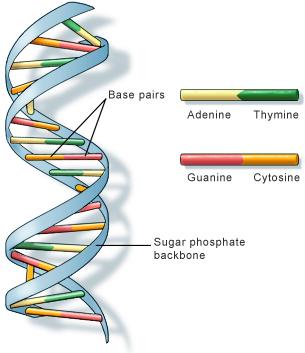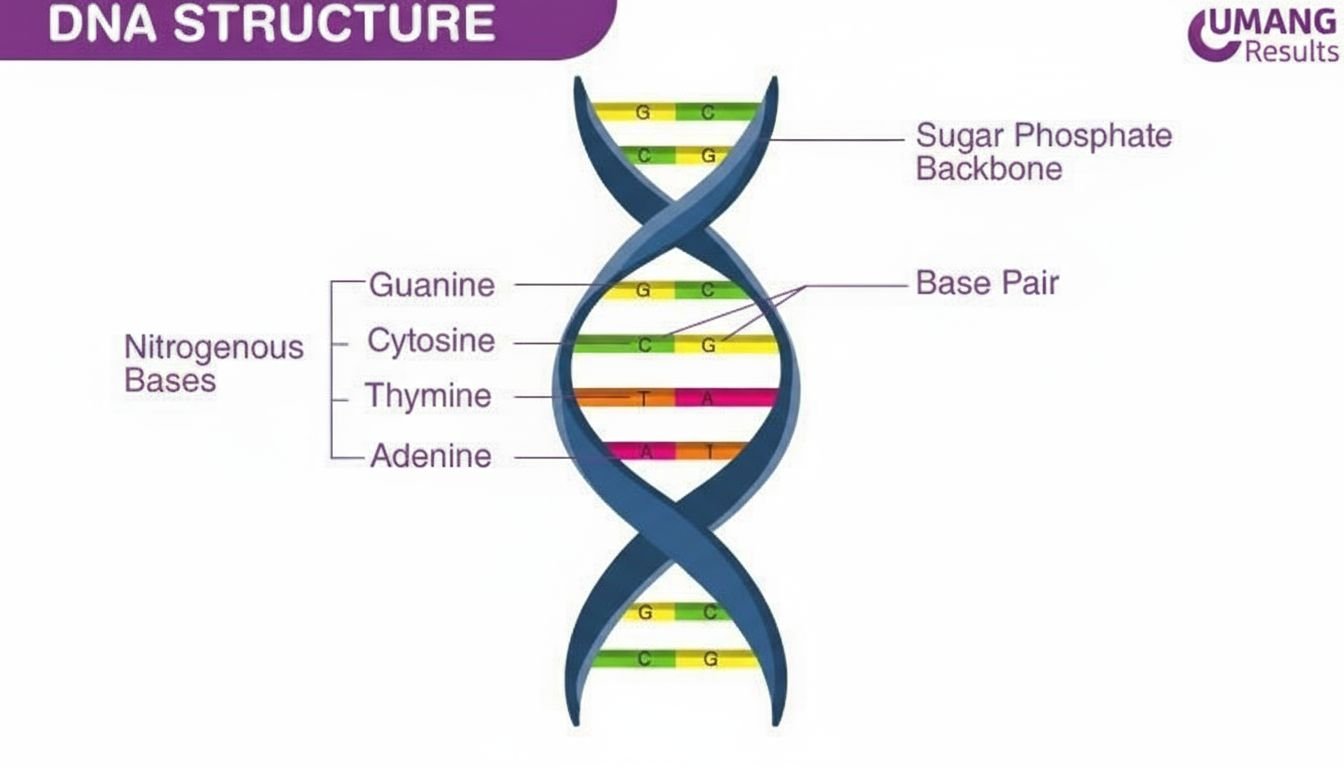DNA or Deoxyribonucleic Acid is one of the most crucial biomolecules studied in Class 12 Biology, especially in Chapter 5 – Molecular Basis of Inheritance (Unit VII) of the NCERT book.
This chapter not only lays the foundation for advanced studies in molecular biology, but also helps students understand as to how traits are inherited, how genetic information is stored, and how it is passed on from one generation to another.
Understanding DNA for Class 12 is a must for both board exams as well as competitive exams like NEET and JEE. Here , we will explore its structure, composition, base pairing rules, packaging of DNA, and real-life importance in detail. Exercises (along with answers) and examples are also included to help strengthen learning.

What is DNA?
DNA or Deoxyribonucleic Acid is a long polymer of deoxyribonucleotides. It is structured as a double helix made of two complementary strands twisted around each other.
DNA carries the genetic blueprint of an organism. Each and living being, from the simplest bacterium to complex humans, has DNA that defines its unique characteristics.
Examples of DNA Content in Organisms
- A bacteriophage Phi X 174 has 5386 nucleotides.
- Bacteriophage Lambda has 48,502 base pairs.
- Escherichia coli (E. coli) has about 4.6 × 10⁶ base pairs.
- The haploid content of human DNA is around 3.3 × 10⁹ base pairs.
This huge variation shows how DNA content increases with the complexity of organisms.
Structure of the Polynucleotide Chain
To understand DNA, we must first know about the polynucleotide chain, the building block of the double helix.
Components of a Nucleotide
A nucleotide, the basic unit of DNA, consists of three components:
- Nitrogenous base
- Pentose sugar (deoxyribose)
- Phosphate group
Types of Nitrogenous Bases
- Purines: Adenine (A) and Guanine (G)
- Pyrimidines: Thymine (T), Cytosine (C), and in RNA, Uracil (U)
Cytosine is common to both DNA and RNA, but DNA has Thymine while RNA has Uracil.
Nucleoside and Nucleotide Formation
- A nitrogenous base + pentose sugar = Nucleoside
Example: Adenosine, Guanosine, Cytidine. - When a phosphate group attaches to the 5′-OH of a nucleoside through a phosphodiester bond, it forms a Nucleotide.
Polynucleotide Chain
- Nucleotides are linked via 3’-5’ phosphodiester bonds, forming a long chain.
- One end has a free phosphate group (5’ end), while the other end has a free hydroxyl group (3’ end).
- The sugar-phosphate backbone supports the structure.
Base Pairing – The Secret of DNA Complementarity
The most fascinating property of DNA is base pairing, which makes the two strands complementary.
- A pairs with T using two hydrogen bonds.
- G pairs with C using three hydrogen bonds.
This base pairing explains how DNA replicates – if one strand is known, the other can be predicted. This ensures that during cell division, identical DNA is passed on to daughter cells.
Salient Features of the Double Helix
The Watson and Crick model of DNA (1953) highlighted the following features:
- DNA is made of two polynucleotide chains.
- The chains have anti-parallel polarity (one runs 5’ → 3’, the other 3’ → 5’).
- Bases are paired through hydrogen bonds (A=T, C≡G).
- The chains coil in a right-handed helix.
- The pitch of the helix is 4 nm, with 10 base pairs per turn.
- The distance between successive base pairs is 34 nm.
This structural precision makes DNA an incredibly stable molecule capable of storing information for millions of years.
Packaging of DNA Helix
One of the biggest puzzles of biology is how a 2.2 metre long DNA molecule fits inside the tiny nucleus of a cell (diameter ~1 μm).
In Prokaryotes (like E. coli)
- DNA is not enclosed in a nucleus.
- It forms a nucleoid with loops held together by proteins.
In Eukaryotes (like Humans)
- DNA is wound around positively charged histone proteins, forming nucleosomes (like “beads on a string”).
- Further coiling and folding results in chromatin, which condenses to form chromosomes during cell division.
This packaging ensures DNA is compact yet accessible for replication and transcription.

Importance of DNA
DNA is more than a molecule – it is the blueprint of life.
Role in Genetics and Inheritance
- DNA carries hereditary information that determines traits like eye colour, height, and blood group.
- During reproduction, DNA is passed from parents to offspring.
Role in Medicine
- DNA study has helped develop genetic testing for disorders like sickle-cell anaemia.
- DNA fingerprinting is used in forensics and paternity testing.
- Gene therapy aims to correct defective DNA.
Role in Biotechnology
- Recombinant DNA technology uses DNA manipulation for producing insulin, vaccines, and genetically modified crops.
Real-Life Example
- The discovery of the DNA double helix structure led to the Human Genome Project, which mapped all human genes and opened doors to personalised medicine.
Exercises for Students
Exercise 1 – Fill in the blanks
- DNA is a long polymer of ____________________.
- Purines include _______________ and _______________.
- In DNA, Adenine always pairs with _______________.
- In humans, the haploid DNA content is _______________.
- The DNA double helix has a pitch of _______________.
Exercise 2 – Short Answer Questions
- Explain the significance of complementary base pairing.
- Differentiate between prokaryotic and eukaryotic DNA packaging.
- Why is DNA considered the blueprint of life?
Exercise 3 – Application Based Question
- If one strand of DNA has the sequence 5’-ATGCAT-3’, write the complementary strand.
Conclusion
Understanding DNA for Class 12 is not only important for board exams but also for appreciating the beauty of life at the molecular level. From being the storage house of genetic information to its role in modern biotechnology and medicine, DNA continues to be one of the most studied and celebrated molecules in science.
For students, mastering the structure, packaging, and importance of DNA lays a solid foundation for higher studies in medicine, genetics, biotechnology, and research.
Answers
Exercise 1 – Fill in the blanks
- DNA is a long polymer of deoxyribonucleotides.
- Purines include Adenine and Guanine.
- In DNA, Adenine always pairs with Thymine.
- In humans, the haploid DNA content is 3 × 10⁹ base pairs.
- The DNA double helix has a pitch of 4 nm.
Exercise 2 – Short Answer Questions
- Explain the significance of complementary base pairing.
- Complementary base pairing (A=T, C≡G) ensures accurate replication of DNA. Each strand serves as a template to form a new strand, making sure genetic information is copied faithfully.
- Differentiate between prokaryotic and eukaryotic DNA packaging.
- In prokaryotes (like E. coli), DNA is arranged in loops held by proteins, forming a nucleoid without a nucleus.
- In eukaryotes (like humans), DNA is wrapped around histone proteins forming nucleosomes (“beads on a string”), further coiled into chromatin and packed into chromosomes during cell division.
- Why is DNA considered the blueprint of life?
- DNA contains instructions for the synthesis of proteins, which control traits, body functions, and metabolism. Since it carries hereditary information passed across generations, it is called the blueprint of life.
Exercise 3 – Application Based Question
If one strand of DNA has the sequence 5’-ATGCAT-3’, write the complementary strand.
Complementary strand = 3’-TACGTA-5’





